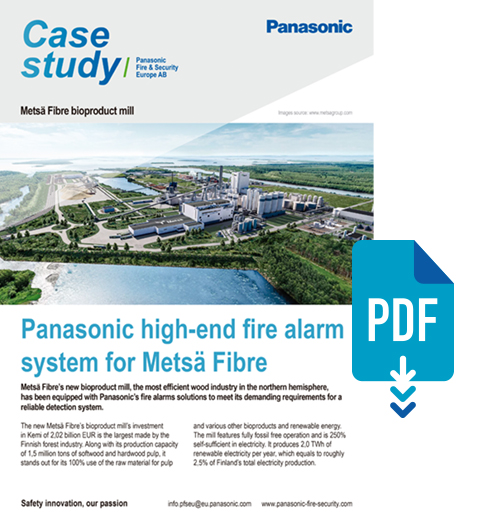The new Metsä Fibre’s bioproduct mill’s investment in Kemi of 2,02 billion EUR is the largest made by the Finnish forest industry the most efficient wood industry in the northern hemisphere. Along with its production capacity of 1,5 million tons of softwood and hardwood pulp, it stands out for its 100% use of the raw material for pulp and various other bioproducts and renewable energy. The mill features fully fossil free operation and is 250% self-sufficient in electricity. It produces 2,0 TWh of renewable electricity per year, which equals to roughly 2,5% of Finland’s total electricity production.
Background
The Metsä Fibre’s, part of Metsä Group, new bioproduct mill project in Kemi is the largest investment ever made by the Finnish forest industry in Finland. A staff of approximately 250 people will process 7,6 million cubic meters of wood annually, and in a wood processing industry of this magnitude is of course the fire protection extremely important.
Understandably, with a total industrial area of 700.000 square meters, detection needs to be both fast and reliable under alternating northern conditions. Outdoor, as well as indoor areas needs to be secured, and with large temperature variations, high humidity and changes in the detection environments only high-quality systems can be considered
Panasonic fire alarm solution

-
30 EBL512 G3 Control Panels connected in a network with a mix of optical fiber and copper wires
-
6.000 smoke and multi detectors with state-of-the-art detection technology
-
More than 100 aspirating detectors for the most challenging environments
-
20 km of linear heat detection with optical fiber
-
Full control of the extinguishing systems by simple programming of I/O units
Conclusion
In large scale facilities with several buildings and large areas like this, the EBL system with its de-centralized architecture is for sure the most efficient solution when it comes to installation time and costs.
The Panasonic fire alarm system offers a top reliability with state-of-the-art detection technology as well as very robust addressable aspirating and EX systems, making it possible to solve this kind of extremely challenging industrial projects. The EBL system additionally facilitates easy integration of 3rd party equipment like linear heat detection and the complete extinguishing system.
Finally, a full integration with the building management system has been done via Panasonic’s OPC UA protocol, included in the Gateway.
Download the case study now to keep it hand.
Images source: www.metsagroup.com.

